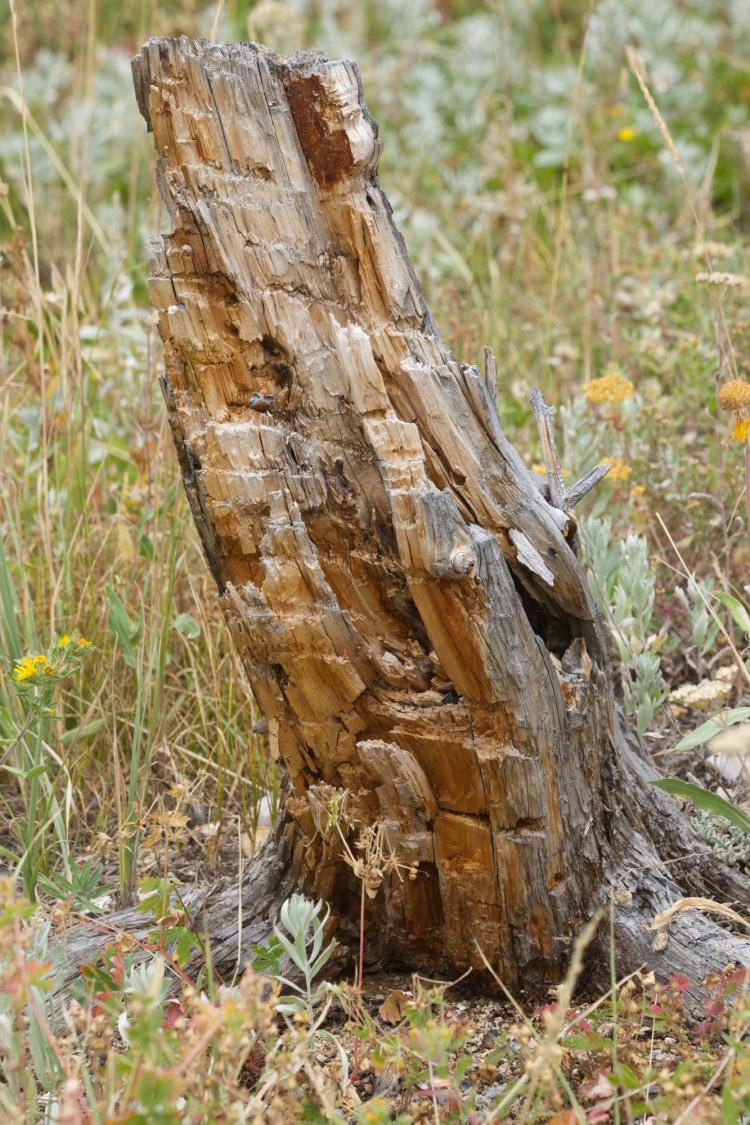Recreational shooting is incompatible with the purposes of Colorado wilderness areas
Here in Colorado, the Forest Service Recreational Sport Shooting Management Project has opened a website to collect opinions on areas to be recommended for recreational shooting at sportshootingpartners.org/commentform/.
Four general plans are under consideration and each has a map to illustrate exactly where recreational shooting is recommended and where it is prohibited. Some of the maps recommend wilderness areas for recreational shooting.
Colorado has 44 wilderness areas and eight of them are included in this management project: Indian Peaks, James Peak, Rawah, Neota, Never Summer, Byers Peak, Vasquez Peak and Mount Evans. This is an important management process, for I suspect that decisions involving these eight wilderness areas will be extended to all 44.
The trunk remaining after recreational shooters felled the tree by shooting at it repeatedly. Click here for larger image. Photo by Jeff Mitton.
Colorado's public lands include national parks, monuments and conservation areas, state parks and wildlife areas, national forests and BLM lands, but wilderness areas are different from all others.
The Wilderness Act of 1964 was "to secure for the American people of present and future generations the benefits of an enduring resource of wilderness" and defined a wilderness area as "an area where the earth and its community of life are untrammeled by man" and "undeveloped Federal land retaining its primeval character and influence ... protected and managed so as to preserve its natural conditions" and "for solitude ..."
When we go to a wilderness area, we want to find the land unchanged by man, plant and animal communities in their natural states, with minimal evidence of and disturbance from other people in the wilderness.
My focus here is on dispersed recreational shooting in wilderness areas. I have no problem with hunting or shooting skeet or target practice in confined areas specifically designed for those activities. Is dispersed recreational shooting an appropriate activity for wilderness areas? I want to share an experience that sheds light on this question.
In the past, I enjoyed visiting an area approximately 200 yards west of the parking area at Sugarloaf Mountain. I frequented the site to photograph wildflowers and the insects attracted to them and other people used the site for dispersed camping.
But recreational shooters took it over, with several of them blasting away as fast as possible. Their intent was to cut down a tree — choose a tree and concentrate fire on it until the tree toppled over. Imagine the sound, which could be heard all the way to Ward and Nederland. Their frenzied racket drove away all others, including me.
In several months, they mowed down more than a dozen live trees — that was their mean and destructive recreation. When the shooters left, every single cartridge case remained on the ground and lead slugs were buried in stumps and sprayed across the landscape.
Recreational shooters have given themselves a very bad name. They have trashed numerous sites between Sugarloaf and the Indian Peaks Wilderness, and as they did so, they drove prudent people away. Hikers, photographers, artists, campers and fly fishermen can share a landscape, but sharing the landscape with rapid-fire weapons is a different matter altogether. Furthermore, littering the landscape with shell casings and poisoning it with lead shot is unacceptable.
It is patently obvious that the antics of recreational shooters are completely inappropriate for wilderness areas. Those public lands were established to preserve natural environments specifically chosen for their beauty and as resources for hiking, camping and other quiet ways of appreciating natural environments, and for the pursuit of solitude and tranquility. The Forest Service should certainly not list wildernesses as sites for recreational shooting, but should discourage all shooting other than hunting.
Our public lands are receiving unprecedented pressures to change their uses. The Bears Ears and Grand Staircase of the Escalante National Monuments are under attack specifically so that those majestic areas can be mined and drilled.
Right now, the Forest Service is being urged to recommend wilderness areas for recreational shooting. It is comfortable to expect that wilderness areas will remain unchanged forever, but that is a naïve notion inappropriate to our times. The cost of wilderness is constant vigilance and immediate action.


